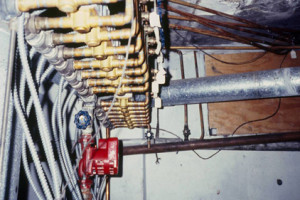We always have turkey for Thanksgiving. I mean who doesn’t? My job wasn’t to cook it, though; it was to eat it.
The Key to Troubleshooting Hydronic Systems

Give water a path and it will take it. But which path? When I was first learning about hydronics, a guy I worked with, who was 15 years older than I was, told me to imagine myself as a marble moving through the pipes. He'd have me feeling the friction as I rolled along the inner surfaces of those pipes. "Here, walk down the hallway and rub your right arm against the wall," he'd say. "Feel the heat? That's friction." That sure worked for me.
He'd also make me visualize the crash of the marble (or the water) as it entered a 90-degree elbow. He'd make me think about what I would do if I entered a tee. Which way would I go? I'd tell him I didn't know. He'd tell me to think and to feel it. "Which is the easiest way?" he'd ask. "Where's the path of least resistance?"
He was so good at making the movement of water visual for me. Even after all these years, if I'm trying to solve a problem with a hot-water system, I'll go back to being that marble. I'm red and blue. Which way would I go? And why?
That's visual thinking. It's key to troubleshooting hydronic systems.
The same goes for those circuits that won't heat. Most contractors immediately think the problem is air so they start purging. But then the no-heat problem returns. Guess what they do next? They purge some more. The same problem returns. They keep purging. They're wrong, but relentless.
Now consider the marble. Suppose it finds an easier path back to the circulator. Remember, all the flow in a hydronic system is going from the discharge of some circulator back to its suction. The water is lazy and it's looking for the shortcut. If there's no heat and purging doesn't work, start thinking about resistance to flow because where there is no flow there is no heat.
Ghost Flow
Engineers talk about Delta-P. They sometimes write it like this: ΔP. It means the difference in pressure between two points. When you put air in your car's tires, the air moves because of a difference in pressure. The greater the difference, the faster the flow of air. The air stops moving when the pressures equalize.
Same goes for water. The greatest pressure differences between two points often happens in the circuits closest to the circulator. The further out into the building you go, the closer those points of pressure differential tend to get. So up on the top floor, you may have little or no movement of water because the water is taking the closer-in path. No flow means no heat, and it looks exactly like an air problem. Don't be fooled, though. If you're purging and not getting any air, it's not an air problem.
So yes, if you give it a path it will take it. There's no question about that. But if you give it a number of paths, as we do in our hydronic systems, the water may not take the one you want it to take. Remember that when you're troubleshooting a no-heat call.
Be the marble.
Or be a ghost-buster!
My father was once the service manager for this manufacturers' rep where we both worked. We sold Bell & Gossett products. B&G made flow-control valves to stop gravity circulation into zones that were off when other zones were on.
Problems showed up during the '70s when the boiler people switched from boilers you could live inside of to those tiny "flash" boilers that came up to temperature faster than you could burp. In fact, that's what B&G called the problem the shoebox boilers were having - "thermal burping." And isn't that a delightfully disgusting way to put it?
The flow-control valves would pop wide open when the boiler raced up to temperature and that led to what we call ghost flow - heat that shouldn't be where it is. This, of course, led to overheated, unhappy customers.
The factory guys suggested that my dad wrap solder around the flow-control valve's weight to give it a bit more resistance to burping. My father and Richie (his serviceman who hated everyone on the planet, and especially our customers) tried, but with mixed results. The water had found its path and it was taking it. Lots of phone calls and plenty of screaming followed.
So Dad had a local machine shop fabricate what he called THE HEAVY INSERT. This was a hunk of brass stock that weighed more than my work boots. He sent Richie, who hated everyone, out to try it in the field and it worked like a charm. To this day, I'm still trying to figure out how the common circulator was able to lift that barbell of an insert when the thermostat called, but I suppose that speaks well for oversized circulators, doesn't it?
At the time, we also learned that ghost flow doesn't need a whole circuit to happen. It just needs one pipe. If the flow-control valves are on the supply pipes, hot water will be more than happy to leave the boiler through the return pipes of the zones that aren't calling. This is especially true if the return drops vertically into the boiler from, say, a bedroom radiator just above. The back end of the radiator will get hot and you'll start thinking that water is flowing backwards. You'll be correct, but it's not the circulator doing it. It's water finding a path it can take. It's ghost flow. The solution is to add a second flow-control valve on the return.
The same applies to primary-secondary pumping. You may need flow-control valves on both sides of your secondary circuits to prevent ghost flow when the secondary circulator is off. I learned that one the hard way and never forgot the lesson.
And take a close look at those old-school compression tanks that continue to hang in old basements. One pipe connects the tank to the boiler or the system piping. Hot water will rise up that pipe by buoyancy, displacing the cold water inside the tank, which will flow downward by gravity through the same pipe. That cold water has absorbed some of the air in the tank, and once the water gets hot, that air will wind up in a radiator. And that's why those old-school tanks often lose their air cushion. You can solve the problem with a tank fitting that stops the gravity circulation, or you can replace the tank with a more modern, diaphragm-type tank, which is what most contractors prefer.
When in doubt, be the marble.
Leave a comment
Related Posts

Back in my rep days, half a lifetime ago, I sold Bell & Gossett circulators. We didn’t have a viable zone valve available at the time, and when the factory finally showed...

I read somewhere that the most prevalent machine in the world is the electric motor. I thought about that for a while and it made sense. Just look around.